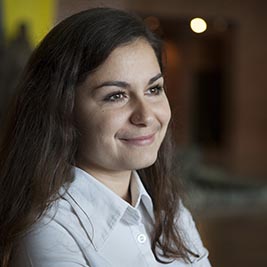Bank of Portraits / Lypynska Kateryna

Kateryna Lypynska
Kateryna Lypynska lived with her husband and two children in the town of Ustyluh in Volhynia.
The town was international, with more than 3,000 Jews living there alongside Ukrainians and Poles. During the occupation, the Nazis began their persecution. In February 1942, the Ustyluh ghetto was established, where nearly 2,000 local Jews were gathered. In the summer of 1942, the ghetto prisoners began to be sent to work in the village of Piatydni in the same Volhynia region. During several weeks, they dug three huge trenches at the former military airfield. On September 1, the shooting of the Jews started and lasted several days. The first victims were nearly 1,500 persons from the town of Ustyluh, then the ghetto residents from Volodymyr-Volynsky (now Volodymyr) were executed. In total, about 15,000 people were murdered in the village of Piatydni.
Very few managed to escape. On September 5, 1942, Kateryna Lypynska entered her barn and heard as if someone was calling her. The voice sounded from the attic. It turned out that was her acquaintance, 18-year-old Henryk (Henry) Orenstein, local Jew, with whom were his elder brothers Shmuel (Seymur) and Felek (Felix), and their father Leib. They luckily escaped the punitive action and were hiding in the workshop for the next few days, the windows of which were closed. The family was exhausted and suffered cold and hunger. Despite the danger, the lady allowed the Ornsteins to stay in the barn, feed them and gave water. They had been hiding in the hay up to September 30, 1942, and nobody of Kateryna’s family members knew about their presence.
Later, under request of Henryk, Kateryna Lypynska contacted local girl, the friend of Felek. Thanks to her, the escapees set connection with their relatives who lived in Hrubieszów (now Lublin province of Poland). This city stood on the opposite left bank of the Western Bug River, that is why the Orensteins asked Kateryna to lead them to the river. There they separated.
Shortly after that, the savior harbored 24-year-old Matilda Gretel in her house. During 18 months, up to expelling of the Nazis from the region, the girl had been hiding in the house or barn of Kateryna Lypynska.
After the war, the Orenstein brothers (their father Leib died in Hrubieszów in 1943) and Matilda Gretel (Topol) moved to the USA, from where they began to help Kateryna Lypynska and her family with products sending sugar, tea, coffee, cigarettes etc. Because of those packages, the KGB chose the savior’s family as a target and began oppressing them in the local newspapers and at the Communist party councils. Eventually, it led to the hard illness of the savior…
On September 7, 1988, the Yad Vashem honored Kateryna Lypynska as the Righteous Among the Nations.

Nadiya Simperovych
Kyiv
National museum of the History of Ukraine in the Second World War
-
fingerprintArtefacts
-
theatersVideo
-
subjectLibrary




